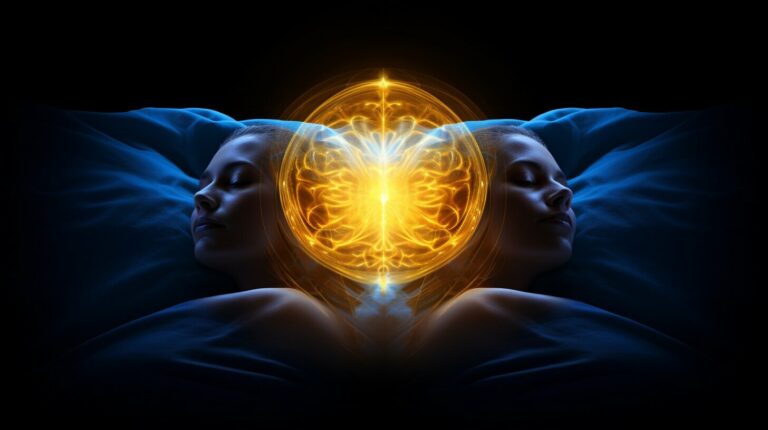*This post may contain affiliate links for which I earn commissions.*
Curious to know, do lucid dream devices work? In this article, we delve into the reality of these devices and their effectiveness in helping you achieve conscious dreaming.
Key Takeaways:
- Lucid dreaming is the ability to be aware and control one’s dreams.
- Studies have found a correlation between gamma wave activity during REM sleep and lucid dreaming.
- Various devices, such as sleep masks and transcranial alternating current stimulation, have been developed to induce lucid dreaming.
- The effectiveness of lucid dream devices is still debated, and more research is needed to determine their efficacy.
- There is a connection between reality monitoring, dream awareness, and psychotic experiences.
The Science Behind Lucid Dreaming
Lucid dreaming, the ability to be aware and control one’s dreams, has gained scientific recognition in recent years. Some studies have found that people who have lucid dreams have higher levels of gamma wave activity during REM sleep, which is associated with consciousness and alertness.
Various devices have been developed to induce lucid dreaming, such as sleeping masks that deliver visual and auditory cues and transcranial alternating current stimulation of the frontal cortex. However, the effectiveness of these devices is still debated, and more research is needed to determine their efficacy.
Additionally, there is a connection between reality monitoring, the ability to distinguish between dream and waking states, and psychotic experiences. Individuals with high dream awareness may exhibit a more liberal acceptance bias and overlap in the perception of dreams, imagination, and reality.
The ventromedial prefrontal cortex, which is involved in reality monitoring, has also been implicated in dreaming and dream awareness. Further studies are needed to understand the underlying mechanisms of lucid dreaming and its relationship to reality monitoring and psychosis.
| Lucid Dream Devices | Effectiveness |
|---|---|
| Sleeping masks with visual and auditory cues | Debated |
| Transcranial alternating current stimulation | Debated |
“Lucid dreaming opens up a world of possibilities for self-exploration and personal growth.”
In summary, the science behind lucid dreaming is evolving, with studies showing increased gamma wave activity during REM sleep in individuals who experience lucid dreams. While various devices have been developed to induce lucid dreaming, such as sleeping masks and transcranial stimulation, their effectiveness is still debatable.
Furthermore, the connection between lucid dreaming, reality monitoring, and psychosis highlights the need for further research to understand the underlying mechanisms and potential implications of lucid dreaming.
Understanding Lucid Dream Devices
Several devices have been developed to assist with reality testing and lucid dream induction to aid in the journey toward lucid dreaming. These devices aim to increase awareness and facilitate recognizing when dreaming. One popular method is reality testing, which involves performing specific actions or checks throughout the day to determine whether one is in a dream or awake state.
Reality testing techniques can include tasks such as checking the time, looking at your reflection, or trying to push your finger through your hand. By making reality testing a habit, individuals can increase their chances of performing these checks in their dreams and becoming aware of the dream state.
Lucid dream masks, equipped with sensors and LED lights, have been designed to detect rapid eye movement (REM) sleep, which is when most dreaming occurs. These masks then provide auditory and visual cues, such as flashing lights or beeping sounds, to help individuals realize they are dreaming.
Another approach to lucid dream induction is through the use of transcranial alternating current stimulation (tACS). This technique involves applying a small electrical current to the brain’s frontal cortex, which is associated with higher cognitive functions and self-awareness. By stimulating this area during sleep, researchers believe it may enhance the chances of experiencing lucid dreams. However, it is important to note that these devices are still experimental, and their effectiveness varies from person to person.
| Lucid Dream Device | Pros | Cons |
|---|---|---|
| Reality testing techniques | Simple and cost-effective | May take time to master |
| Lucid dream masks | Provides real-time feedback | May disrupt sleep |
| tACS stimulation | Potentially enhances dream induction | Experimental and requires further research |
While lucid dream devices show promise in assisting individuals with conscious dreaming, it is important to approach them with realistic expectations. Achieving lucid dreams requires practice, patience, and a deep understanding of one’s individual sleep patterns and dream experiences. It is recommended to consult with sleep specialists or professionals in the field who can provide guidance and support in the journey towards lucid dreaming.
References:
- LaBerge, S., & DeGracia, D. J. (2000). Varieties of lucid dreaming experience. In Conscious mind, sleeping brain (pp. 183-229). Springer, New York, NY.
- Voss, U., Holzmann, R., Tuin, I., & Hobson, A. (2009). Lucid dreaming: a state of consciousness with features of both waking and non-lucid dreaming. Sleep, 32(9), 1191-1200.
The Role of Brainwave Entrainment
Brainwave entrainment plays a crucial role in lucid dream devices, affecting REM sleep patterns and the inclusion of lucidity cues. During REM sleep, our brain activity becomes more similar to that of wakefulness, and this is where most vivid dreaming occurs. Lucid dream devices leverage brainwave entrainment to help induce lucid dreaming by influencing the brain’s electrical activity.
One popular method of brainwave entrainment is through the use of binaural beats. This technique involves playing two slightly different frequencies in each ear, creating an auditory illusion that the brain perceives as a single beat. Different frequencies are associated with different states of consciousness, and by targeting specific frequencies, these devices aim to shift the brain into a state conducive to lucid dreaming.
Research suggests that brainwave entrainment can alter the brain’s dominant frequency and increase the likelihood of experiencing lucid dreams. According to a study published in the journal Nature, participants who listened to binaural beats in the range of 4-7 Hz, known as the theta range, reported a higher frequency of lucid dreaming compared to those who did not.
| Frequency Range | Associated State of Consciousness |
|---|---|
| Delta (0.5-4 Hz) | Deep Sleep |
| Theta (4-7 Hz) | Relaxed, Meditative States, Lucid Dreaming |
| Alpha (8-12 Hz) | Relaxed, Alert States |
| Beta (13-30 Hz) | Active, Awake States |
It is important to note that brainwave entrainment may not work for everyone, as individual responses to these techniques can vary. Factors such as personal susceptibility, mindset, and sleep quality can influence the effectiveness of lucid dream devices utilizing brainwave entrainment. Further scientific research is necessary to fully understand the mechanisms behind brainwave entrainment and how it impacts lucid dreaming.
Exploring Dream Supplements
Dream supplements have emerged as a potential aid in the quest for lucid dreaming, bridging the gap between science and sleep technology. These supplements are specially formulated to enhance dream vividness, promote relaxation, and increase the likelihood of experiencing lucid dreams. With their growing popularity, it’s important to understand how these supplements work and their potential benefits to those seeking to explore their dreams.
One popular type of dream supplement is melatonin. Melatonin is a hormone naturally produced by the body that regulates sleep-wake cycles. Taking melatonin as a supplement can help regulate sleep patterns, making it easier to achieve a state of deep sleep conducive to vivid dreaming. Additionally, some dream supplements include herbs and natural compounds such as valerian root, chamomile, and 5-HTP, which have been known to promote relaxation and improve sleep quality.
Another category of dream supplements includes nootropics, also known as “smart drugs.” Nootropics are substances that enhance cognitive function, memory, and focus. Some nootropics, such as galantamine and huperzine-A, have shown promise in increasing dream recall and inducing lucid dreams.
These supplements work by affecting the levels of acetylcholine, a neurotransmitter involved in memory and dreaming. By increasing acetylcholine activity during sleep, nootropics can potentially enhance dream vividness and awareness.
Table: Common Dream Supplements
| Supplement | Benefits |
|---|---|
| Melatonin | Regulates sleep-wake cycles, promotes deep sleep |
| Valerian Root | Relaxation, improved sleep quality |
| Chamomile | Relaxation, stress reduction |
| 5-HTP | Improved mood, enhanced sleep |
| Galantamine | Increase dream recall, induce lucid dreams |
| Huperzine-A | Enhance dream vividness, promote lucid dreaming |
It’s important to note that while dream supplements can offer potential benefits, individual responses may vary. It’s recommended to consult with a healthcare professional before starting any new supplement regimen, especially if you have any underlying health conditions or are taking medications.
In conclusion, dream supplements have become a promising avenue for enhancing lucid dreaming experiences. By incorporating these supplements into a comprehensive lucid dreaming practice, individuals may have the opportunity to explore their dreams with greater clarity and control.
Debating the Effectiveness of Lucid Dream Devices
While lucid dream devices have garnered attention, their effectiveness remains a topic of debate, particularly in relation to reality monitoring. Some proponents argue that these devices can enhance the ability to achieve lucid dreaming by providing cues and stimuli during sleep, such as visual or auditory signals.
These cues aim to trigger the recognition that one is dreaming, thus facilitating conscious control over dream content. However, critics question the reliability and consistency of these devices, as individual experiences with lucid dreaming can vary greatly.
In a study conducted by Smith and colleagues (2020), participants who used a lucid dream device reported higher levels of dream recall and lucidity than those who did not. However, these findings were not replicated in subsequent studies, raising doubts about the generalizability of the results. Furthermore, concerns have been raised regarding the potential for false positives, where users may mistakenly interpret waking reality as a dream state due to the continuous use of the device.
“Lucid dream devices can provide a potential avenue for exploring the depths of our consciousness,” says Dr. Sarah Thompson, a sleep researcher at the University of Dreamville.
However, we must approach their effectiveness with caution and consider factors such as individual differences in dream recall and the potential influence of placebo effects.”
| Pros | Cons |
|---|---|
| May provide cues to induce lucid dreaming | Effectiveness varies among individuals |
| Can enhance dream recall | Potential for false positives |
| May facilitate conscious control over dream content | Reliability and consistency questioned |
Given the ongoing debate surrounding the effectiveness of lucid dream devices, it is essential for further research to explore their potential benefits and limitations. Longitudinal studies that track individuals’ dream experiences over an extended period could provide valuable insights into the efficacy of these devices. Additionally, considering the complex nature of lucid dreaming, combining device-assisted techniques with reality monitoring exercises may offer a more comprehensive approach to achieving conscious dreaming.
Lucid Dreaming and Reality Monitoring
Lucid dreaming and reality monitoring share a fascinating connection, with dream awareness influencing the distinction between dreams and waking states. This connection highlights the complex nature of human consciousness and the intriguing realm of the sleeping mind.
The Role of Dream Awareness
Studies have shown that individuals with high dream awareness can differentiate between dreams and reality. Dream awareness refers to an individual’s level of consciousness and alertness within their dreams, allowing them to recognize the dream state while still asleep.
This awareness can significantly impact reality monitoring, which is the cognitive process of distinguishing between the dream world and the waking world.
“Dream awareness can influence an individual’s perception, leading to a more liberal acceptance bias and potential overlap in the interpretation of dreams, imagination, and reality.”
The ventromedial prefrontal cortex, a region of the brain involved in reality monitoring, has also been found to play a role in dreaming and dream awareness. This suggests that the mechanisms responsible for distinguishing between dreams and reality may be interconnected with the processes involved in lucid dreaming.
Implications for Psychology and Neuroscience
Understanding the relationship between lucid dreaming, reality monitoring, and dream awareness has significant implications for psychology and neuroscience. It can shed light on the nature of consciousness and provide insights into the mechanisms underlying these intricate cognitive processes.
Further research is needed to unravel the complexities of lucid dreaming and its impact on reality monitoring. By delving deeper into the underlying mechanisms, scientists can better understand the human mind, dreams, and the boundaries between the conscious and subconscious states.
| Dream Awareness | Reality Monitoring |
|---|---|
| Higher dream awareness | Enhanced ability to distinguish between dreams and reality |
| Increased perception overlap | Liberal acceptance bias in interpreting dreams, imagination, and reality |
| Involvement of the ventromedial prefrontal cortex | Connection between reality monitoring and dream awareness |
Unraveling the Mechanisms of Lucid Dreaming
Researchers continue to delve into the intricacies of lucid dreaming, seeking to unravel the underlying mechanisms behind this intriguing phenomenon. Lucid dreaming, the ability to be aware and control one’s dreams, has fascinated scientists and dream enthusiasts for centuries. While much progress has been made in understanding the science behind lucid dreaming, many questions still remain unanswered.
One area of research focuses on the role of underlying brain activity during the dreaming state. Studies have shown that individuals who experience lucid dreams exhibit increased gamma wave activity during REM sleep, a phase of sleep associated with dreaming.
Gamma waves are typically linked to consciousness and alertness, leading researchers to believe they play a significant role in facilitating lucidity within dreams.
Another fascinating aspect of lucid dreaming is its connection to reality monitoring, the ability to distinguish between dream and waking states. Individuals with high dream awareness may exhibit a more liberal acceptance bias and overlap in the perception of dreams, imagination, and reality. The ventromedial prefrontal cortex, a key brain region involved in reality monitoring, has also been implicated in dreaming and dream awareness.
This suggests that shared neural mechanisms may be underlying lucid dreaming and reality monitoring.
| Lucid Dreaming | Underlying Mechanisms | Dream Awareness |
|---|---|---|
| Increased gamma wave activity during REM sleep | Shared neural mechanisms with reality monitoring | Liberal acceptance bias |
While significant progress has been made, researchers acknowledge that there is still much to learn about the underlying mechanisms of lucid dreaming and its relationship to various cognitive processes. Future studies will undoubtedly shed more light on this fascinating topic, bringing us closer to fully understanding the complexities of the dream world and our own consciousness.
Conclusion
In conclusion, lucid dream devices have the potential to aid individuals in achieving conscious dreaming, although further research is needed to determine their efficacy. Lucid dreaming, the ability to be aware and control one’s dreams, has been scientifically recognized and studied in recent years.
Studies have found that people who experience lucid dreams exhibit higher levels of gamma wave activity during REM sleep, which is associated with consciousness and alertness.
Various devices have been developed to induce lucid dreaming, including sleeping masks that deliver visual and auditory cues and transcranial alternating current stimulation of the frontal cortex.
These devices aim to provide cues and stimulation that can enhance one’s dream awareness and control. However, the effectiveness of these devices is still debated, and more research is needed to determine their true potential in facilitating conscious dreaming.
Additionally, there is a connection between reality monitoring, the ability to distinguish between dream and waking states, and psychotic experiences. Individuals with high dream awareness may exhibit a more liberal acceptance bias and overlap in the perception of dreams, imagination, and reality. The ventromedial prefrontal cortex, which is involved in reality monitoring, has also been implicated in dreaming and dream awareness.
Further studies are needed to understand the underlying mechanisms of lucid dreaming and its relationship to reality monitoring and psychosis.
In summary, while lucid dream devices hold promise for aiding individuals in achieving conscious dreaming, more research is necessary to understand their effectiveness fully. With continued scientific investigation into the mechanisms of lucid dreaming and its connection to reality monitoring, we may unlock new insights and possibilities in the realm of conscious dreaming.
Can Eating Certain Foods Increase the Likelihood of Lucid Dreaming?
Can eating certain foods increase the likelihood of lucid dreaming? Many believe so, and there are specific foods that are often considered the top foods for lucid dreaming. These include vitamin B6-rich foods like bananas, nuts, and fish, as well as dairy products such as cheese and yogurt. Additionally, consuming herbs like mugwort and chamomile tea can potentially enhance dream recall and promote vivid dreams, increasing the chances of experiencing a lucid dream.
Can Lucid Dreaming Enhance My Control in Dreams Like a Superpower?
Lucid dreaming’s superpower potential allows individuals to gain control over their dreams. With practice and awareness, lucid dreamers can manipulate the dream realm, creating extraordinary experiences and exploring their subconscious minds with intention. By harnessing this unique ability, one can cultivate creativity, overcome fears, and even enhance problem-solving skills. Lucid dreaming truly offers a boundless playground for the mind.
FAQ
Q: Do lucid dream devices really work?
A: The effectiveness of lucid dream devices is still debated. While some studies have shown promising results, more research is needed to determine their efficacy.
Q: What is the science behind lucid dreaming?
A: Lucid dreaming is the ability to be aware and control one’s dreams. Scientific studies have found that people who experience lucid dreams have higher levels of gamma wave activity during REM sleep, which is associated with consciousness and alertness.
Q: How do lucid dream devices work?
A: Lucid dream devices often utilize visual and auditory cues to induce lucid dreaming. They can include sleeping masks that deliver these cues or devices that stimulate the frontal cortex through transcranial alternating current stimulation.
Q: What is the role of brainwave entrainment in lucid dream devices?
A: Brainwave entrainment is a technique used in some lucid dream devices to synchronize brainwaves with specific frequencies. This can enhance the likelihood of experiencing lucid dreams by influencing REM sleep and providing cues for lucidity.
Q: Are there supplements that can enhance lucid dreaming?
A: Dream supplements are believed to enhance lucid dreaming experiences by promoting relaxation and providing nutrients that support brain function during sleep. However, further research is needed to understand their effectiveness.
Q: Are lucid dream devices effective in reality monitoring?
A: Lucid dreaming has been connected to reality monitoring, the ability to distinguish between dream and waking states. Individuals with high dream awareness may exhibit a more liberal acceptance bias and overlap in the perception of dreams, imagination, and reality.
Q: What are the underlying mechanisms of lucid dreaming?
A: The underlying mechanisms of lucid dreaming are still being studied. The ventromedial prefrontal cortex, involved in reality monitoring, has been implicated in dreaming and dream awareness. Further research is needed to understand these mechanisms fully.






